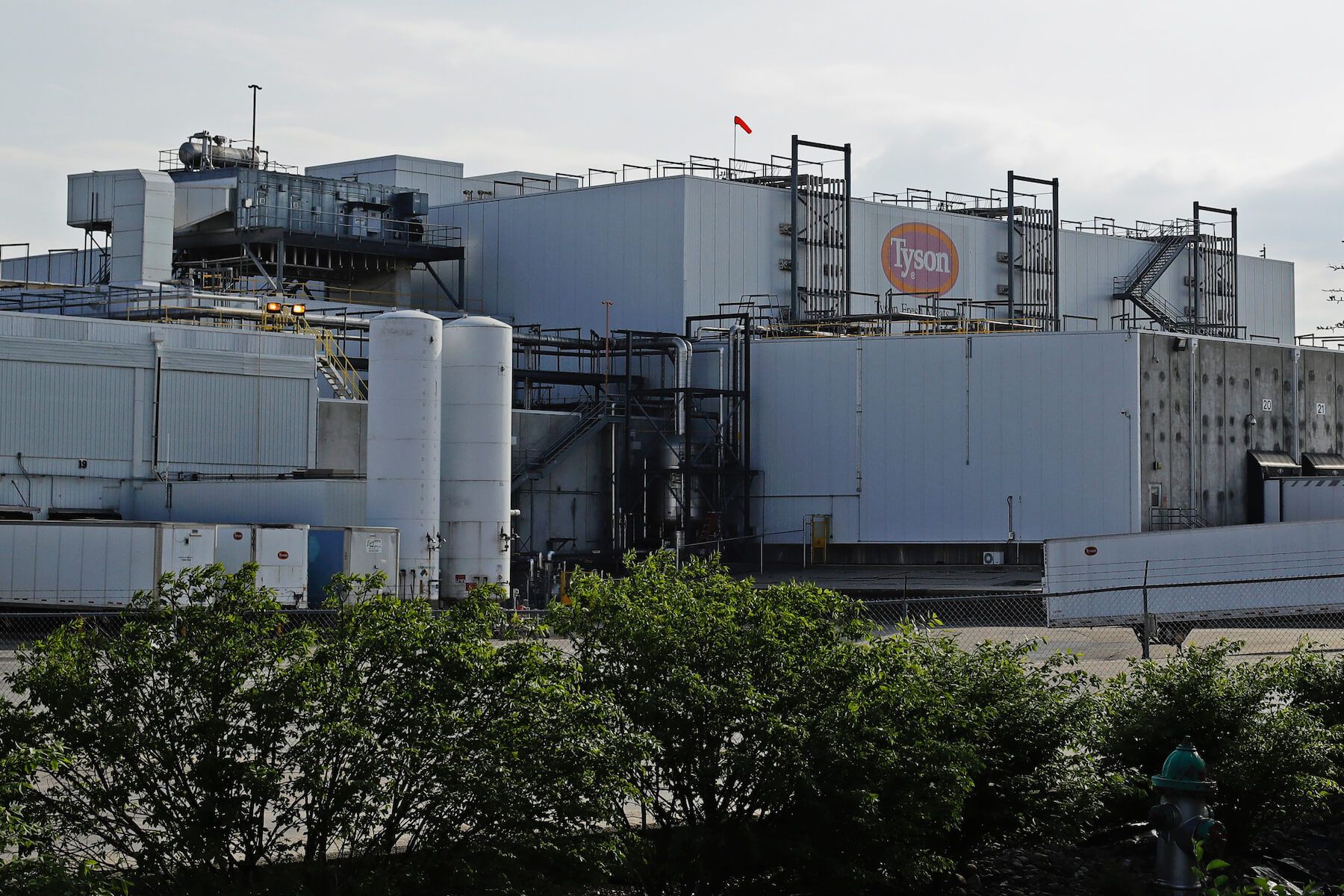
AP Photo/Charlie Riedel
For ranchers, workers, and retailers, the pandemic has been a crisis. For the meatpackers who dominate 80 percent of the beef market, it’s been a rare opportunity.
For a brief, four-day period last week, two of the Midwest’s largest beef packing plants were both shut down at the same time. Together, those Nebraska facilities—the Tyson Foods plant in Dakota City and the Cargill plant in Schuyler—can process a combined 13,000 animals per day, more than 10 percent of America’s total cattle slaughter. At first glance, this turn of events seemed to be what Tyson Foods chairman John H. Tyson warned about when, in a recent, open letter to the public, he claimed “the food supply chain is breaking.”
Above, a Tyson Fresh Meats beef plant in Emporia, Kansas, as seen on Monday, April 27, 2020. According to the Emporia Gazette, 48 confirmed cases of the novel coronavirus have been traced to the facility.
But while plant closures create the appearance of a system in chaos, stoking anxieties about shortages and empty shelves, they don’t necessarily hurt meatpackers themselves. In fact, for the handful of large meatpackers who dominate the beef industry, closing down plants can actually increase profits. For these companies, at least so far, Covid-19 appears to be more opportunity than crisis.
That’s not to say that plant closures are economically beneficial across the board—far from it. Pandemic-related disruptions in meat processing have imperiled workers’ livelihoods, made meat more expensive in grocery stores, and have cost livestock producers millions in lost profits. But the four meatpackers who control more than 80 percent of cattle slaughter in the U.S.—Tyson, Cargill, JBS, and National Beef, known collectively as the Big Four—will likely be just fine. In fact, they’re structured in a way that insulates them from the worst economic impacts of this crisis—and may emerge from it even stronger.
So far this year, Covid-19 has had a strange, counterintuitive impact on beef prices: While the price of live cattle has gone down, the cost of their meat has become much more expensive. Industry insiders call this disparity the “meat margin”: the difference between what meatpackers pay for cattle and the price they charge for meat. As that margin widens, meatpackers spend less to make much more.
Those profits have increased enough that Tyson has signaled it will voluntarily reduce the amount it charges grocery stores for meat. Perhaps in response to increased regulator interest over meat indusry pricing strategies, or perhaps out of fear that higher prices will simpy drive consumers away from the meat aisle, Tyson on Wednesday told The Wall Street Journal it would decrease some beef prices by 20 to 30 percent—a concession to retailers that may help keep end prices from rising further.
“They’re buying cattle at historically low prices right now, and selling into a tremendous, historically unheard-of market.”
In a blog post on his website last week, Jayson Lusk, an agricultural economist at Perdue University, charted cattle prices against wholesale beef prices. He found that wholesale beef prices—the price retailers pay meatpackers—rose 67 percent between the weeks of January 3 and May 1. According to data from the National Cattlemen’s Beef Association, a trade organization representing beef producers and packers, grocery stores are paying as much as double for some products.
“If you look at the price level, that’s higher than any price in the last 20 years,” Lusk said. “Pork prices have been rising at a very similar rate.”
“Those rising prices are reflecting scarcity,” he added. The problem isn’t so much an overall lack of meat. It’s more that plant closures have coincided with retailers seeing additional demand as restaurants remain closed or limited. In a perfect world, all that meat bound for restaurants could be redirected to grocery stores. But as we reported last month, it’s not so simple: Packing plants can’t shift from producing 40-pound boxes of meat to single-serving styrofoam containers overnight.
To an extent, these increases are being passed on to the public: Nielsen data indicate that grocery stores are charging 10 percent more for meat of all kinds compared to this time last year, while sales of fresh and processed meat at the beginning of May were up nearly 50 percent from the same time period in 2019. Beef, specifically, has become more expensive: Nielsen reports that beef prices are up 10.9 percent overall compared to this time last year. While food purchases overall were up about 66 percent as people stayed home and restaurants remained shuttered, the meat department was seeing more sales growth than any other section of the grocery store.
But Lusk also found that, while retail prices went up, something odd happened: the price of live cattle actually decreased by 24 percent over the same period.
This isn’t the way supply and demand is supposed to work. When demand for meat goes up, whether it’s because consumers are stocking up or for any other reason, prices are supposed to rise across the board—not just at retail, but in commodity livestock markets, too. But that’s not what’s happening right now. Instead, cattle prices are declining, which means that, while average Americans are paying more, retailers are paying more, and producers are earning less, meatpackers stand to increase profits by a significant margin.
Lusk cautions that the marketing margins may not tell the whole story. It’s possible the meatpackers are spending more money on workplace safety equipment and hazard pay for workers. In his blog post, he points to slumping stock prices for JBS and Tyson as possible evidence that they aren’t making record profits as workers continue to fall sick and protest plants re-opening. Cargill declined to comment for this story. Tyson and JBS had not responded to questions by press time.
But, in cattle country, the perception is that Covid-19 plant closures have only helped meatpackers—a possibility the raw numbers make difficult to ignore.
“They’re buying cattle at historically low prices right now, and selling into a tremendous, historically unheard-of market—unheard of what they’re getting for the beef today,” said Herman Schumacher, a cattle producer and feedlot operator based in Herreid, South Dakota.
To see this dynamic at play, and to understand why it has the potential to benefit large meatpackers at the expense of agricultural producers and the public, we don’t need wait and see how the pandemic shakes out. We need only look back to the summer of 2019, when a devastating fire in Holcomb, Kansas set the stage for what we’re seeing now.
On August 9, 2019, a Tyson Foods beef plant in Holcomb was set ablaze, likely due to a spark from a piece of welding equipment, according to the company. The plant, which could slaughter 6,000 head of cattle a day, about 5 percent of the U.S. total, was rendered totally out of commission. On the surface, it seemed to be a huge setback for Tyson. But in the days that followed, beef packer profits more than doubled—not just for Tyson, but across the industry.
The reason? The closure of one major plant left thousands of cattle ranchers across the Midwest without a place to slaughter their animals, causing temporary supply gluts at the facilities that remained. After the fire, cattle prices in the South dropped to their lowest in two years, Cassie Fish, a U.S. beef expert, told Reuters.
In many regions of the country, large packing plants are few and far between, and Big Four meatpackers have a virtual monopoly on slaughter. That market power gives them enormous clout, and can result in perverse financial incentives: While the temporary closure of a plant might seem unfortunate for a meat processor, it can actually boost their bottom lines.
Plant closures tend to send cattle markets plunging, while spooking the public and driving up prices on the retail side.
In general, livestock producers don’t have much control over when they sell their animals; holding animals for days or weeks past their prime can mean a huge drop in quality, which results in financial losses. “When they get them ready to go and then they can’t go, it really hurts,” said Harlan Hughes, an agricultural economist and professor emeritus at the North Dakota State University Extension Service. When a closed plant sends a sudden influx of cattle to other slaughterhouses, which can still process only a set number of animals per day, it results in a buyer’s market—significantly lowering the price paid per head.
Those spot prices, in turn, depress the price paid to ranchers who operate under “forward contracts,” or agreements that commit a farmer or rancher to sell cattle to a specific meatpacker on a given date, according to that day’s prices. In this way, one major plant’s closure can influence prices across the entire system.
Critics have long alleged that Big Four meatpackers use occasional plant closures as a strategy, wielding them as a competitive tool. Last year, a lawsuit against the nation’s top beef packers alleged that they had routinely closed plants under false pretenses, using closures to sink prices—and raise their own profits—in just this way. Though the Holcomb fire appears to have been an accident, it still had the same impact: a significant widening of the “meat margin.”
Meatpackers couldn’t have seen Covid-19 coming. But today, every successive plant closure is another Holcomb: an event that sends cattle markets plunging, while spooking the public and driving up prices on the retail side.
“We had a little warning shot last summer, the massive fire at the Tyson plant in Holcomb, Kansas,” said Jim Schaben, who runs a cattle sale barn in Dunlap, Iowa. “That was prelude to what we’re going through now—only that was like the dike was leaking. Now, we’ve breached the dike and it is flooding.”
Schaben holds livestock auctions in Nebraska and Iowa each week. Typically, he said, he’ll usually sell 400 to 500 cattle this time of year, as well as 300 to 500 “weigh cows”—dairy cows that have exhausted their milk and are destined to enter the meat supply. As of last week, he was seeing a tiny fraction of those sales: just 35 cattle, and 150 weigh cows. Eric Nelson, an Iowa cattle rancher, said he hadn’t received a bid on any of his cattle in five weeks, a lengthy delay he said was unlike anything he’d ever experienced.
That slowdown has helped to depress cattle prices in the regions where slaughter plants have remained open, or have come back on line. As of May 11, cattle prices were more than 10 percent below where they were at this time last year.
And even if meatpackers can find a way to keep plants open throughout the pandemic—as a recent executive order from President Trump seems designed to help them do—they’ll still face a huge backlog of animals that need to be processed right away.
USDA data show that nearly 615,000 fewer cattle were slaughtered in the weeks since March 28 than during the same time span last year, a sign that suggests a backlog of around that many cattle. That’s a huge problem for ranchers already desperate to sell. According to Hughes, large meat plants already operate at full capacity: they can’t easily process more just because more animals are suddenly on hand. Historically, the way to increase bandwidth has been to operate on Saturdays, when plants are typically closed. But processing many thousands of additional animals on one extra day a week may take weeks or months, meaning that the current market dynamic may not be reduced any time soon.
Schumacher, the South Dakota cattle producer, said the inability for ranchers to send their cattle to slaughter has caused widespread despair and chaos—worse than anything he’s seen in his near 50-year career. In desperation, he plans to drive a lot of 200 cattle to the closest available facility he can find: the small, custom slaughter plant run by his friend Mike Callicrate, a rancher and retailer based in St. Francis, Kansas, nearly a nine-hour drive south.
“This is the highest stress level ever,” Schumacher said. “It’s a complete meltdown.”

